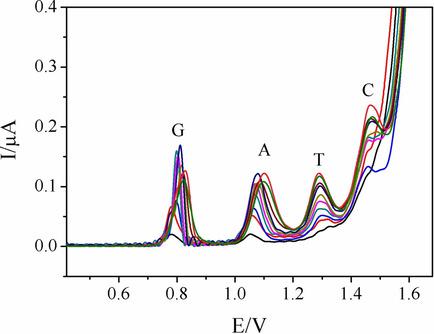当前位置:
X-MOL 学术
›
Electroanalysis
›
论文详情
Our official English website, www.x-mol.net, welcomes your
feedback! (Note: you will need to create a separate account there.)
Application of Different Carbon Materials for Carbon Paste Electrodes to Simultaneous Electrochemical Detection of four DNA Bases with High Simpleness
Electroanalysis ( IF 2.7 ) Pub Date : 2018-04-06 , DOI: 10.1002/elan.201700805 Xiaping Zhu 1 , Yali Yuan 1, 2, 3 , Yun Zhang 1 , Jianping Li 1 , Hongcheng Pan 1
Electroanalysis ( IF 2.7 ) Pub Date : 2018-04-06 , DOI: 10.1002/elan.201700805 Xiaping Zhu 1 , Yali Yuan 1, 2, 3 , Yun Zhang 1 , Jianping Li 1 , Hongcheng Pan 1
Affiliation

|
Three different carbon materials, graphite, graphene and multiwalled carbon nanotubes (MWCNTs), were applied to fabricate carbon paste electrodes and used directly as working electrodes without any further modification in a simple electrochemical system for simultaneous detection of four DNA bases, guanine, adenine, thymine and cytosine. EIS and SEM were used to characterize the formed carbon paste electrodes made from different carbon nanomaterials and silicon oil, respectively. Conditions for bases detection were studied, such as ratio of carbon nanomaterials to silicon oil, types of buffer saline and pH. An unexpected result was discovered that compared with graphite and graphene, MWCNTs in carbon paste electrodes were not able to obtain admirable electrochemical behavior, the possible reason of which was preliminary discussed. Individual and simultaneous detection of four bases were successfully carried out, with acceptable linear ranges and low detection limits. Furthermore, this facile method had admirable reproducibility, stability and acceptable recovery in real urine sample (97.62 % ∼103.36 %), indicating certain practical potential.
中文翻译:

碳糊电极用不同碳材料在同时电化学检测四个简单性高的DNA碱基中的应用
将三种不同的碳材料(石墨,石墨烯和多壁碳纳米管(MWCNT))用于制造碳糊电极,并直接用作工作电极,无需任何进一步修改即可在简单的电化学系统中同时检测四个DNA碱基,鸟嘌呤,腺嘌呤,胸腺嘧啶和胞嘧啶。EIS和SEM分别用于表征由不同碳纳米材料和硅油制成的碳糊电极。研究了用于碱基检测的条件,例如碳纳米材料与硅油的比例,缓冲盐水的类型和pH。发现了一个出乎意料的结果,与石墨和石墨烯相比,碳糊电极中的MWCNTs不能获得令人赞叹的电化学性能,对此可能的原因进行了初步讨论。在可接受的线性范围和低检测限范围内,成功地分别检测了四个碱基。此外,该方法在真实尿液样品中具有很好的重现性,稳定性和可接受的回收率(97.62%〜103.36%),具有一定的实用价值。
更新日期:2018-04-06
中文翻译:

碳糊电极用不同碳材料在同时电化学检测四个简单性高的DNA碱基中的应用
将三种不同的碳材料(石墨,石墨烯和多壁碳纳米管(MWCNT))用于制造碳糊电极,并直接用作工作电极,无需任何进一步修改即可在简单的电化学系统中同时检测四个DNA碱基,鸟嘌呤,腺嘌呤,胸腺嘧啶和胞嘧啶。EIS和SEM分别用于表征由不同碳纳米材料和硅油制成的碳糊电极。研究了用于碱基检测的条件,例如碳纳米材料与硅油的比例,缓冲盐水的类型和pH。发现了一个出乎意料的结果,与石墨和石墨烯相比,碳糊电极中的MWCNTs不能获得令人赞叹的电化学性能,对此可能的原因进行了初步讨论。在可接受的线性范围和低检测限范围内,成功地分别检测了四个碱基。此外,该方法在真实尿液样品中具有很好的重现性,稳定性和可接受的回收率(97.62%〜103.36%),具有一定的实用价值。











































 京公网安备 11010802027423号
京公网安备 11010802027423号